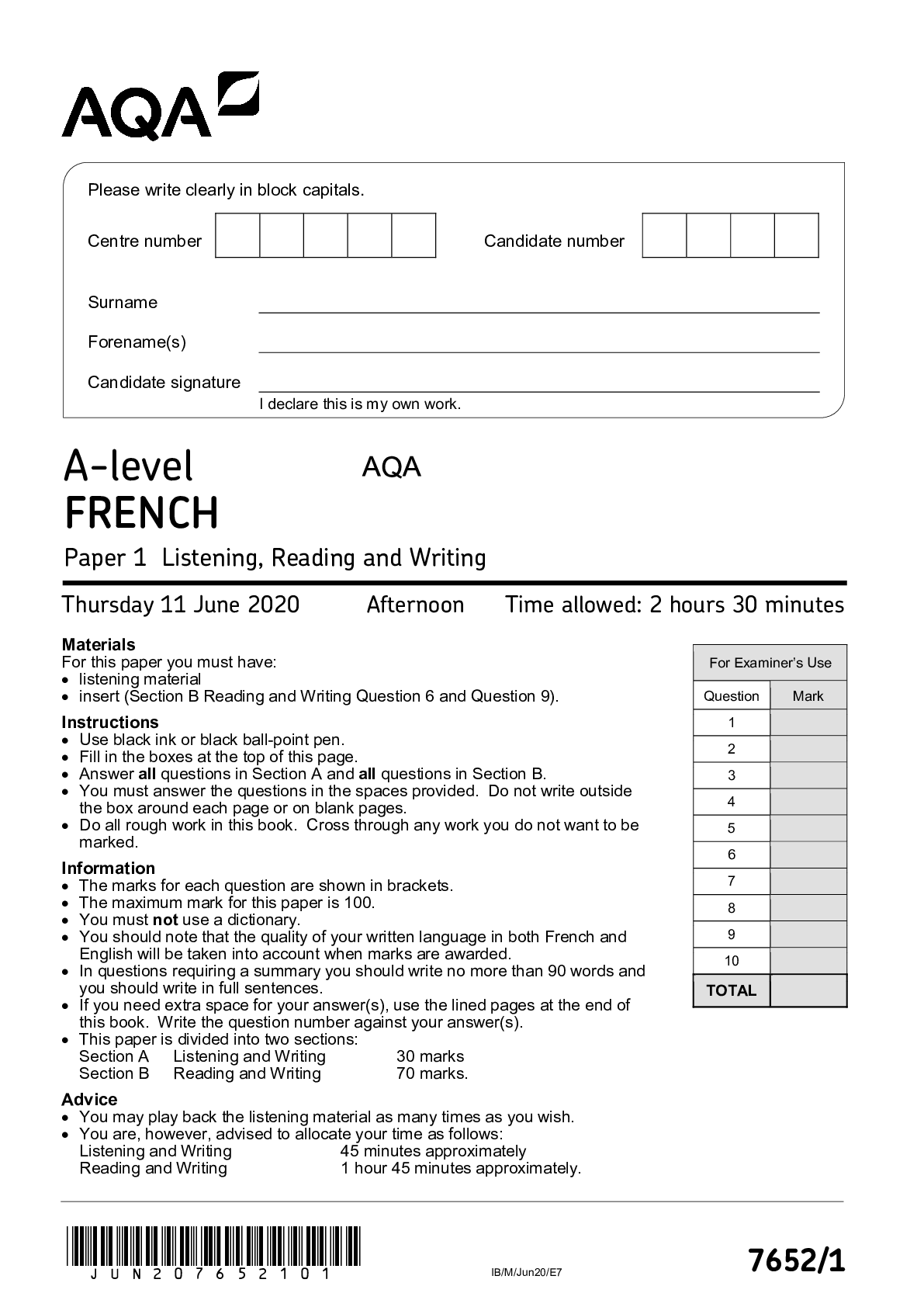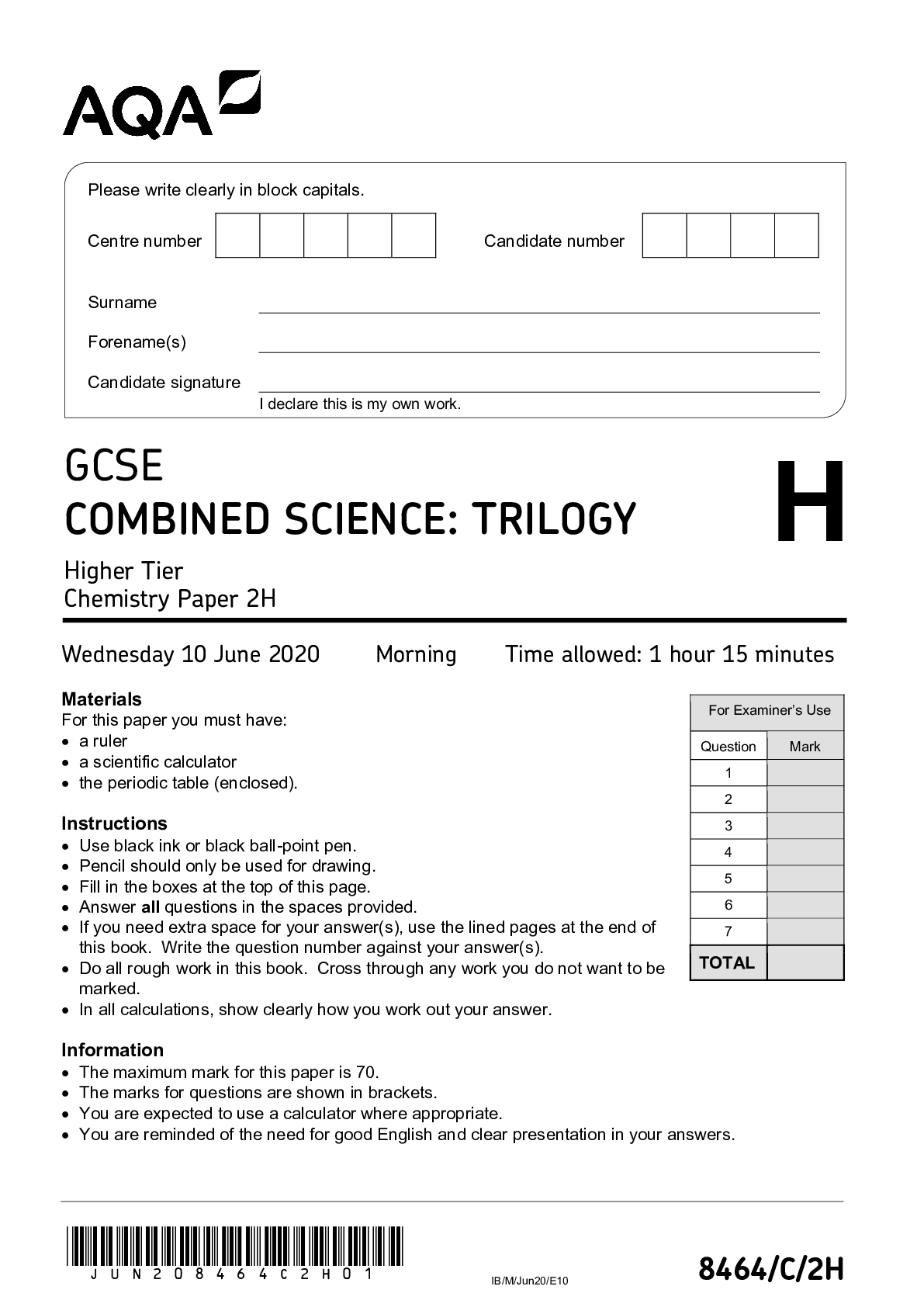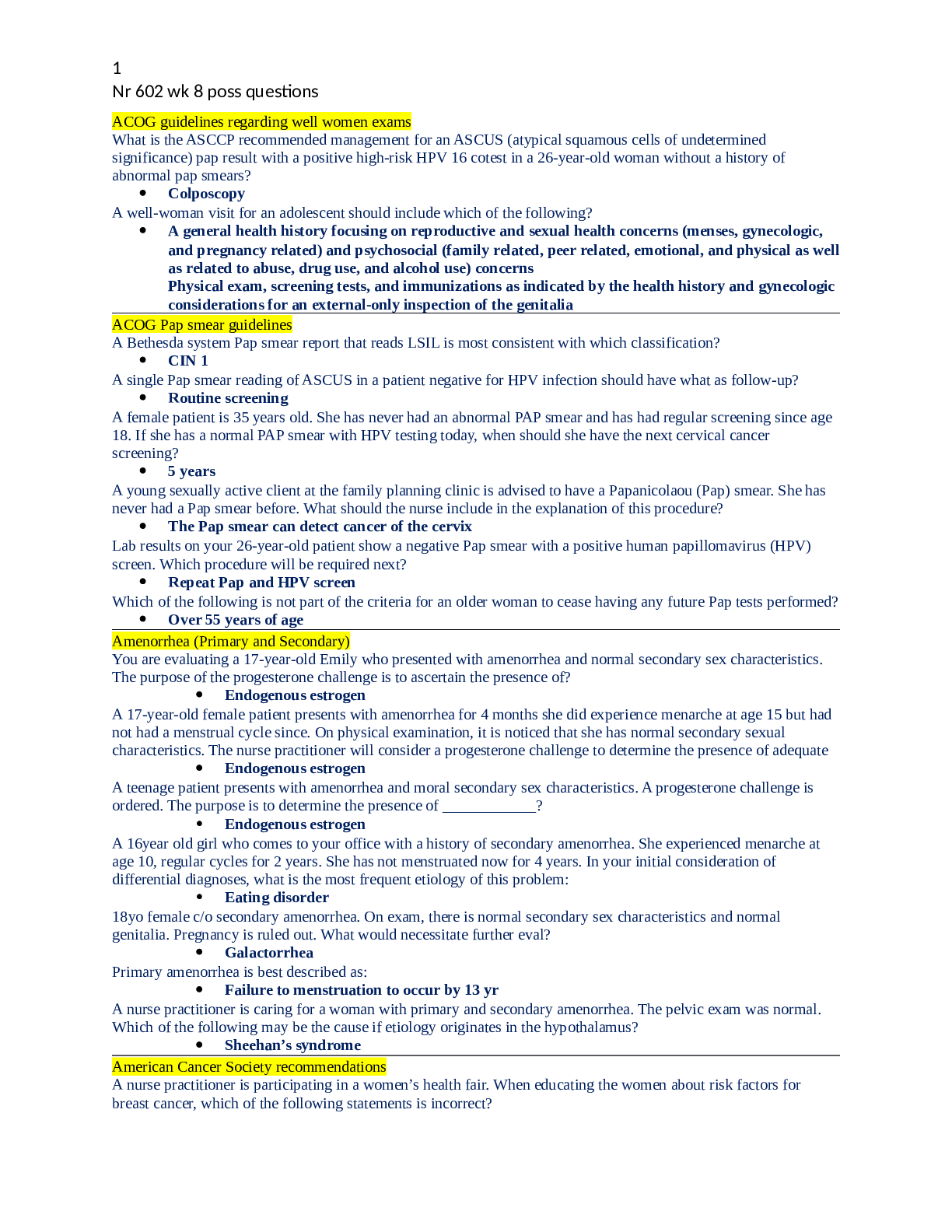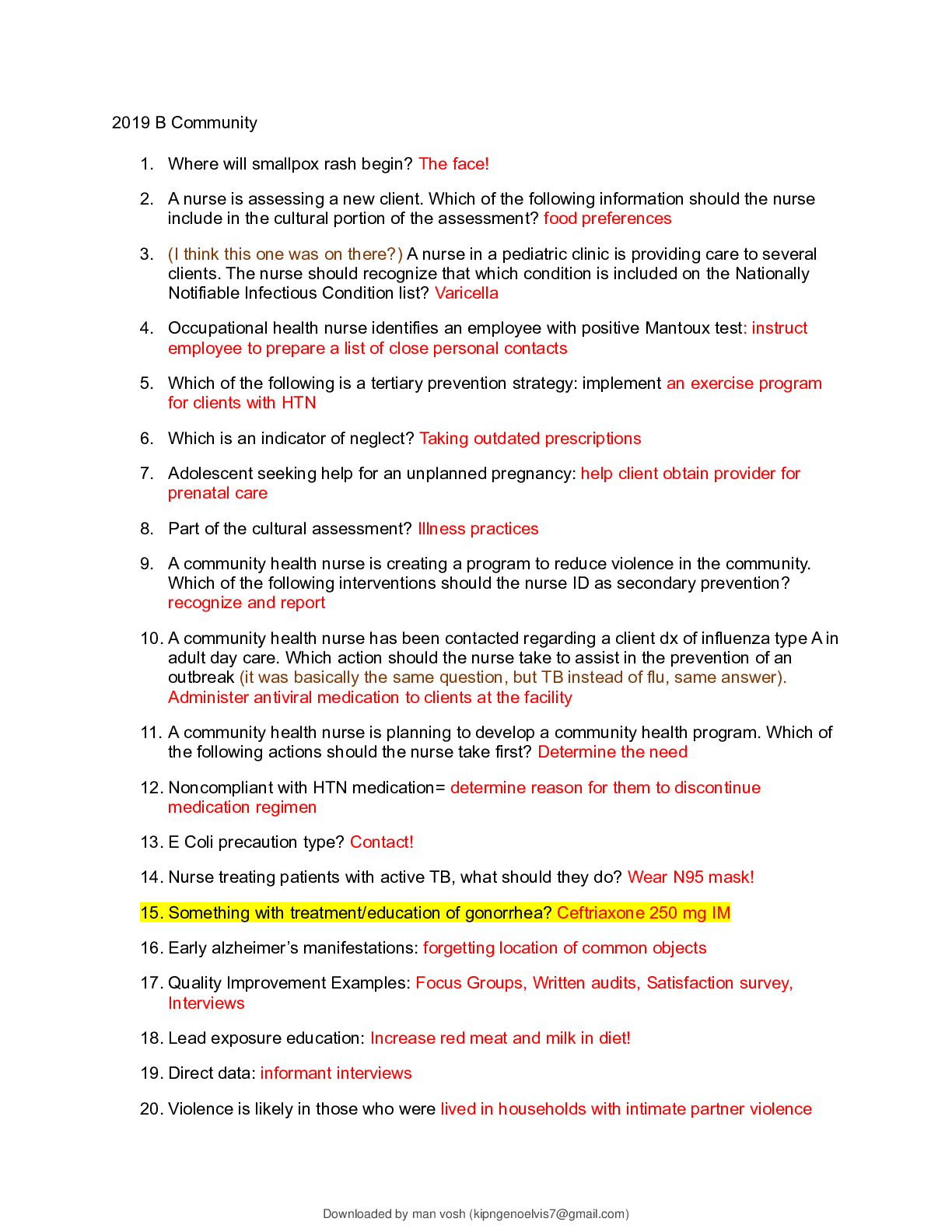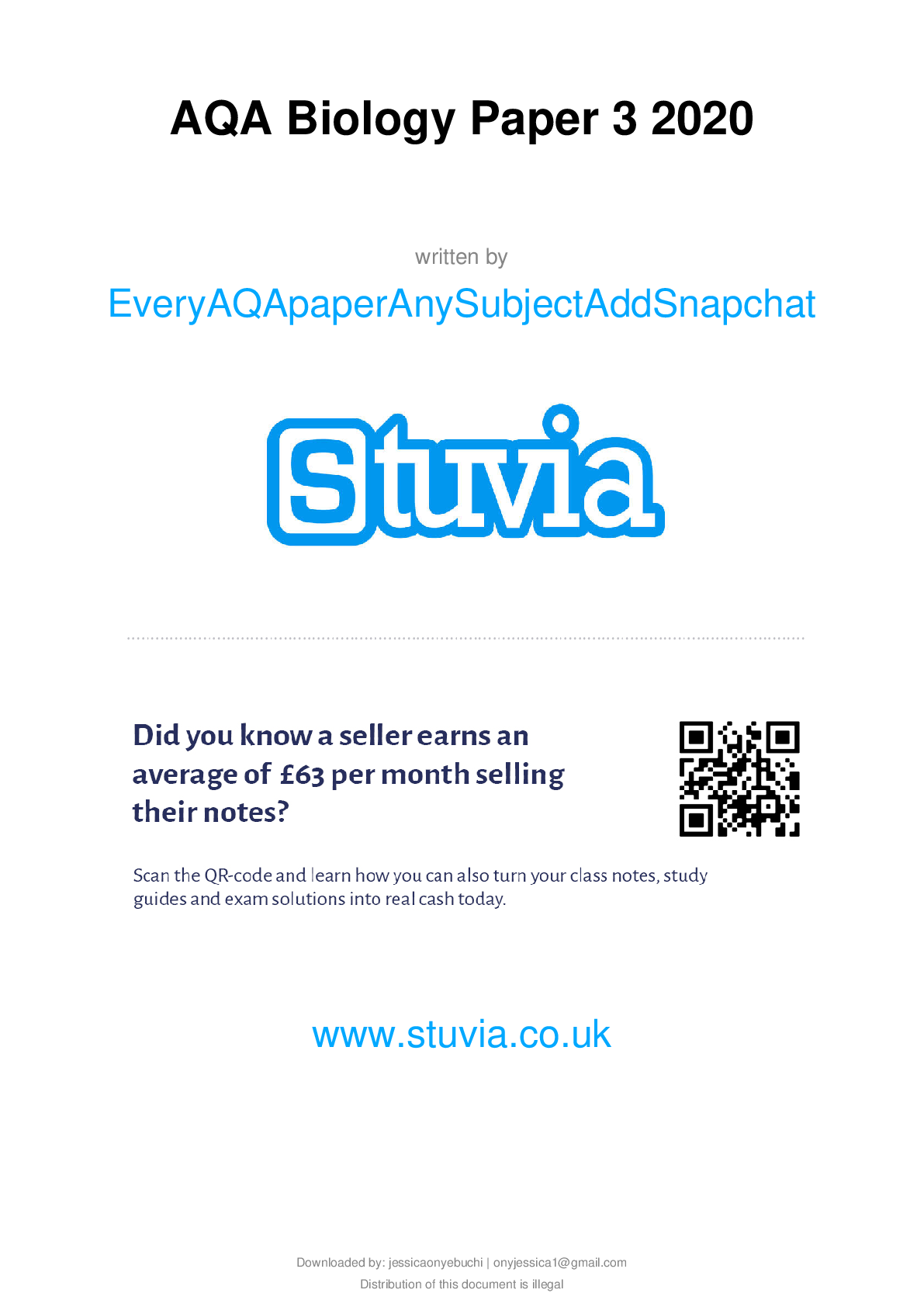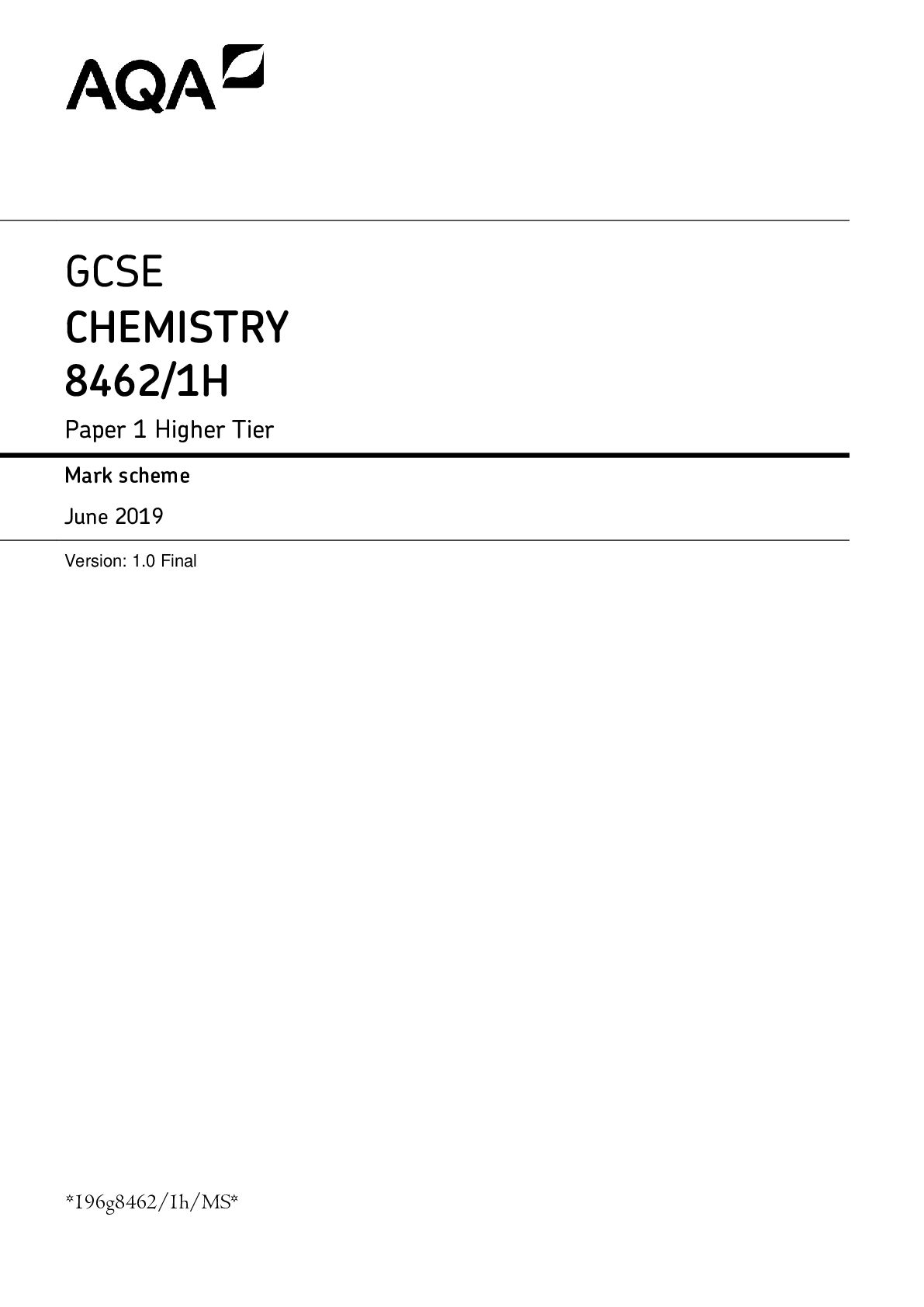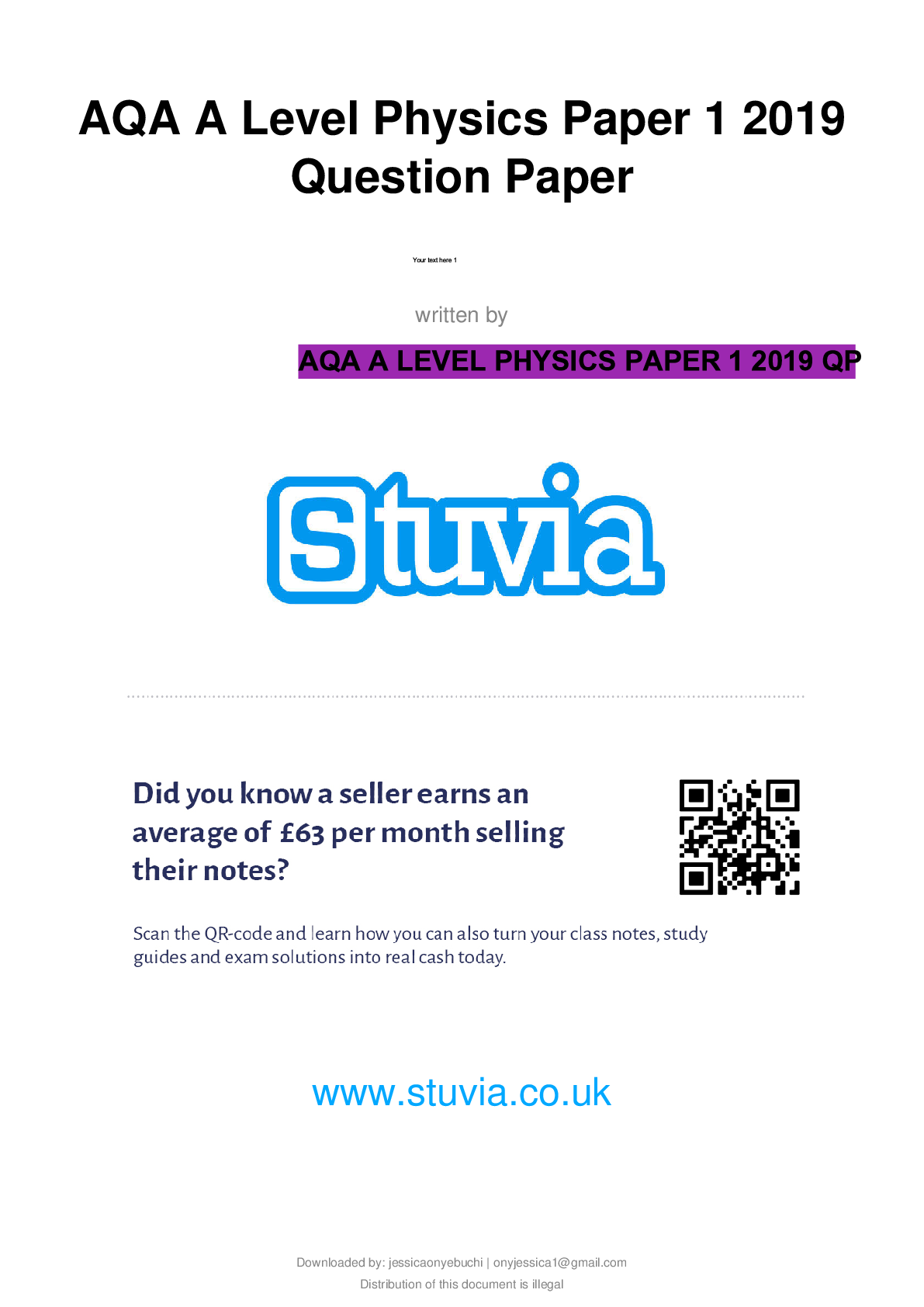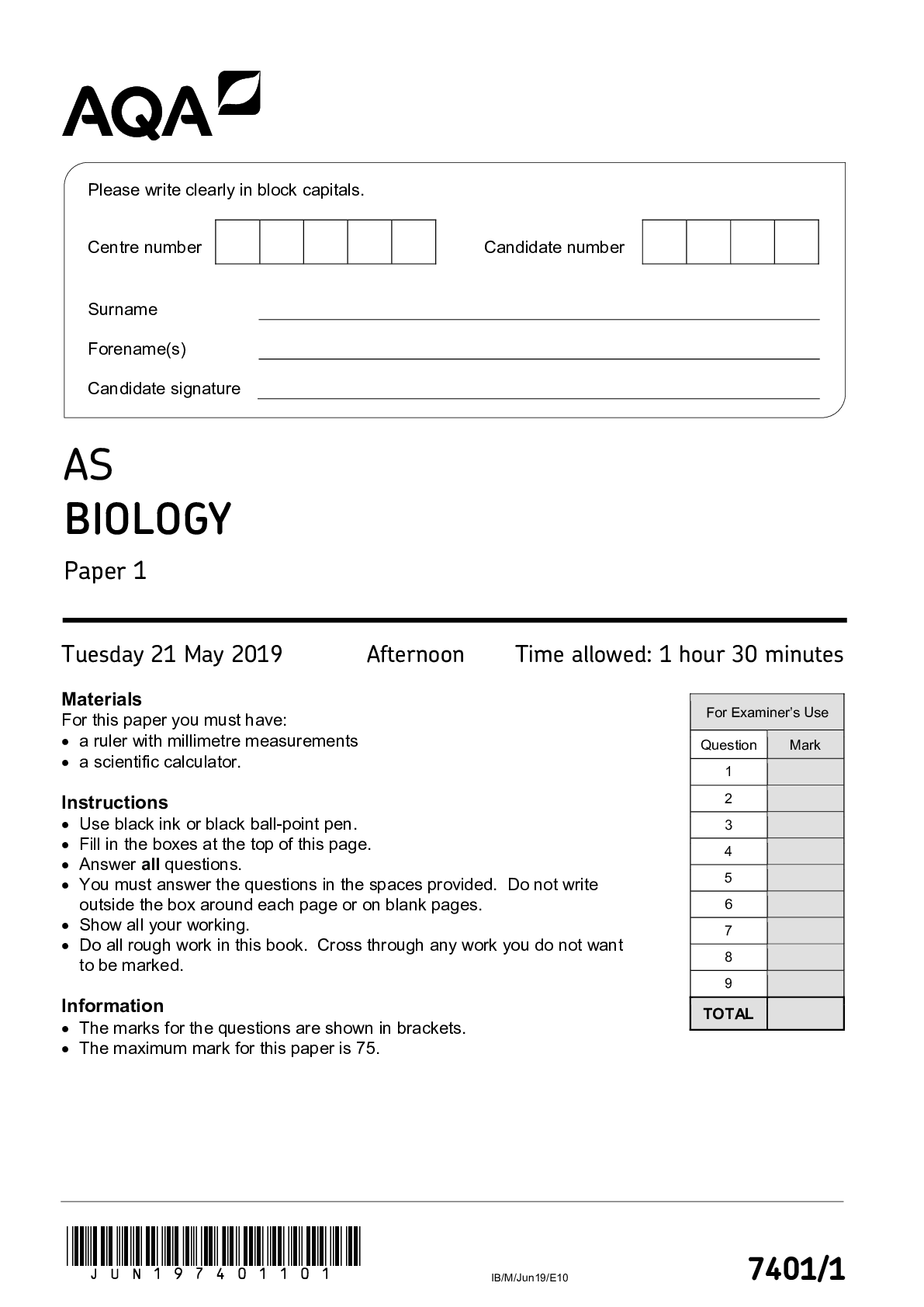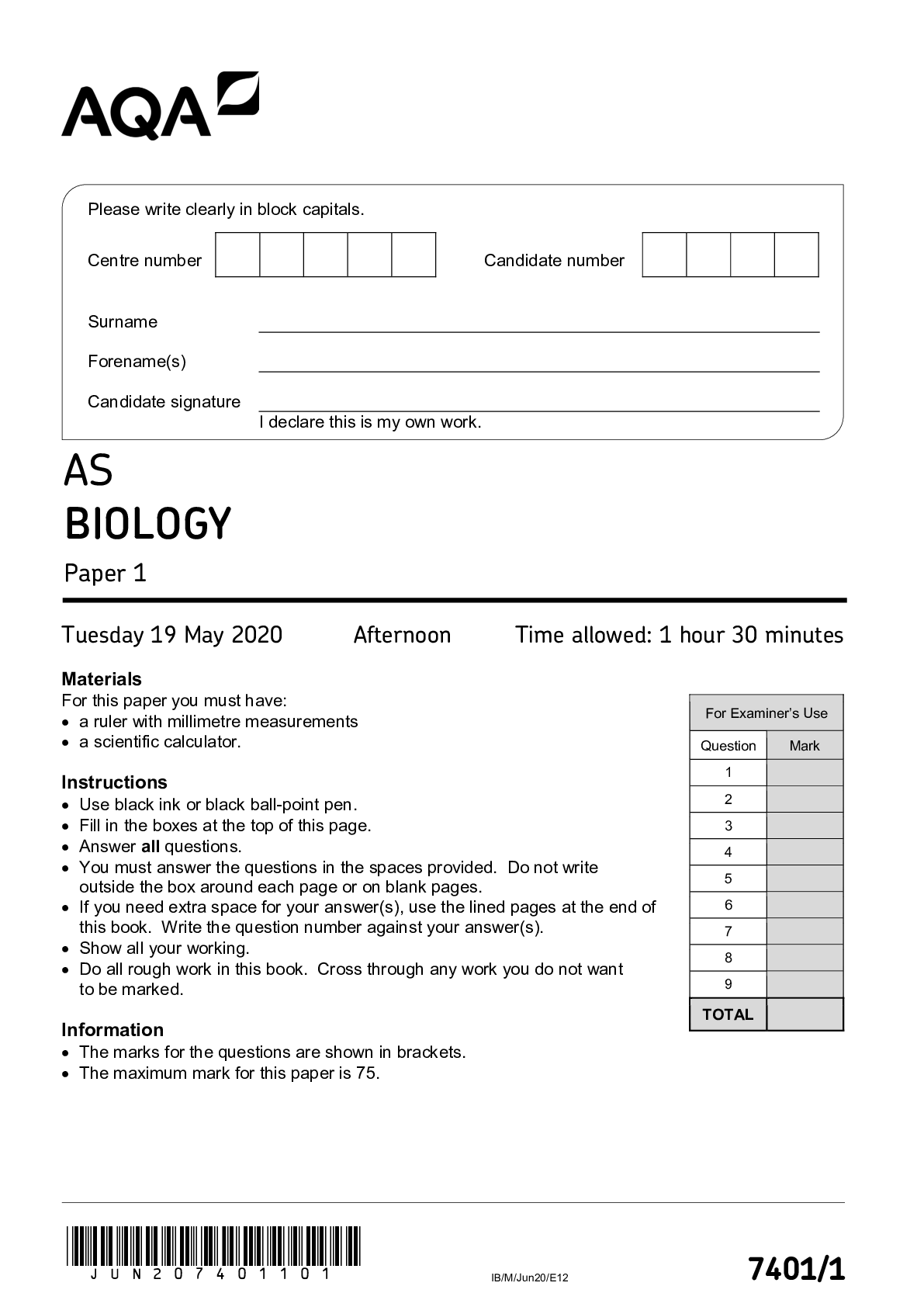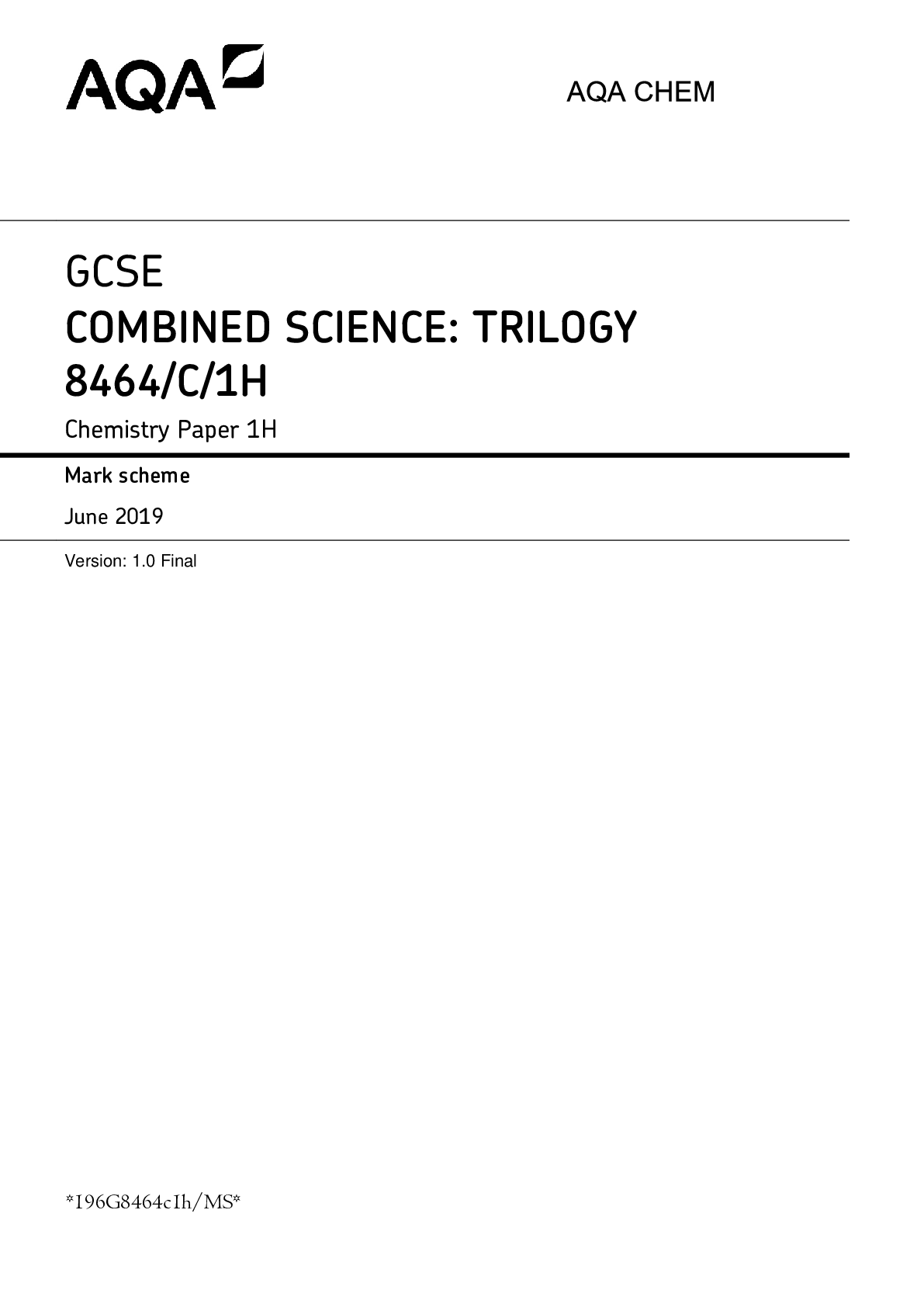8702_1_PreS_MS_Jun20_v0.2__2_.
Document Content and Description Below
Assessment of AO4 AO4 will be assessed on Section A only. The performance descriptors are provided below. Performance descriptor Marks awarded High performance: In the context of the level of dema... nd of the question, learners spell and punctuate with consistent accuracy, and consistently use vocabulary and sentence structures to achieve effective control of meaning. 4 marks Intermediate performance: In the context of the level of demand of the question, learners spell and punctuate with considerable accuracy, and use a considerable range of vocabulary and sentence structures to achieve general control of meaning. 2–3 marks Threshold performance: In the context of the level of demand of the question, learners spell and punctuate with reasonable accuracy, and use a reasonable range of vocabulary and sentence structures; any errors do not hinder meaning in the response. 1 mark Where a candidate writes nothing or fails to meet threshold performance they should receive 0 marks. MARK SCHEME – GCSE ENGLISH LITERATURE – 8702/1 – JUNE 2020 8 Sections A and B: Questions 1–13 (30 marks – AO1=12, AO2=12, AO3=6) Mark AO Typical features How to arrive at a mark Level 6 Convincing, critical analysis and exploration 26–30 marks AO1 • Critical, exploratory, conceptualised response to task and whole text. • Judicious use of precise references to support interpretation(s). At the top of the level, a candidate’s response is likely to be a critical, exploratory, well-structured argument. It takes a conceptualised approach to the full task supported by a range of judicious references. There will be a fine-grained and insightful analysis of methods supported by judicious use of subject terminology. Convincing exploration of one or more ideas/perspectives/contextual factors/interpretations. At the bottom of the level, a candidate will have Level 5 and be starting to demonstrate elements of exploratory thought and/or analysis of writer’s methods and/or contexts. AO2 • Analysis of writer’s methods with subject terminology used judiciously. • Exploration of effects of writer’s methods to create meanings. AO3 • Exploration of ideas/perspectives/contextual factors shown by specific, detailed links between context/text/task. Level 5 Thoughtful, developed consideration 21–25 marks AO1 • Thoughtful, developed response to task and whole text. • Apt references integrated into interpretation(s). At the top of the level, a candidate’s response is likely to be thoughtful, detailed and developed. It takes a considered approach to the full task with references integrated into interpretation; there will be a detailed examination of the effects of methods supported by apt use of subject terminology. Examination of ideas/perspectives/contextual factors, possibly including alternative interpretations/deeper meanings. At the bottom of the level, a candidate will have Level 4 and be starting to demonstrate elements of thoughtful consideration and/or examination of writer’s methods and/or contexts. AO2 • Examination of writer’s methods with subject terminology used effectively to support consideration of methods. • Examination of effects of writer’s methods to create meanings. AO3 • Thoughtful consideration of ideas/perspectives/contextual factors shown by examination of detailed links between context/text/task. MARK SCHEME – GCSE ENGLISH LITERATURE – 8702/1 – JUNE 2020 9 Level 4 Clear understanding 16–20 marks AO1 • Clear, explained response to task and whole text. • Effective use of references to support explanation. At the top of the level, a candidate’s response is likely to be clear, sustained and consistent. It takes a focused response to the full task which demonstrates clear understanding. It uses a range of references effectively to illustrate and justify explanation; there will be clear explanation of the effects of a range of writer’s methods supported by appropriate use of subject terminology. Clear understanding of ideas/perspectives/contextual factors. At the bottom of the level, a candidate will have Level 3 and be starting to demonstrate elements of understanding and/or explanation of writer’s methods and/or contexts. AO2 • Clear explanation of writer’s methods with appropriate use of relevant subject terminology. • Understanding of effects of writer’s methods to create meanings. AO3 • Clear understanding of ideas/perspectives/ contextual factors shown by specific links between context/text/task. Level 3 Explained, structured comments 11–15 marks AO1 • Some explained response to task and whole text. • References used to support a range of relevant comments. At the top of the level, a candidate’s response is likely to be explanatory in parts. It focuses on the full task with a range of points exemplified by relevant references from the text; there will be identification of effects of a range of writer’s methods supported by some relevant terminology. Explanation of some relevant contextual factors. At the bottom of the level, a candidate will have Level 2 and be starting to explain and/or make relevant comments on writer’s methods and/or contexts. AO2 • Explained/relevant comments on writer’s methods with some relevant use of subject terminology. • Identification of effects of writer’s methods to create meanings. AO3 • Some understanding of implicit ideas/ perspectives/contextual factors shown by links between context/text/task. MARK SCHEME – GCSE ENGLISH LITERATURE – 8702/1 – JUNE 2020 10 Level 2 Supported, relevant comments 6–10 marks AO1 • Supported response to task and text. • Comments on references. At the top of the level, a candidate’s response is likely to be relevant and supported by some explanation. It will include some focus on the task with relevant comments and some supporting references from the text. There will be identification of deliberate choices made by the writer with some reference to subject terminology. Awareness of some contextual factors. At the bottom of the level, a candidate’s response will have Level 1 and be starting to focus on the task and/or starting to show awareness of the writer making deliberate choices and/or awareness of contexts. AO2 • Identification of writers’ methods. • Some reference to subject terminology. AO3 • Some awareness of implicit ideas/contextual factors. Level 1 Simple, explicit comments 1–5 marks AO1 • Simple comments relevant to task and text. • Reference to relevant details. At the top of the level, a candidate’s response is likely to be narrative and/or descriptive in approach. It may include awareness of the task and provide appropriate reference to text; there will be simple identification of method with possible reference to subject terminology. Simple comments/responses to context, usually explicit. At the bottom of the level, a candidate’s response will show some familiarity with the text. AO2 • Awareness of writer making choices. • Possible reference to subject terminology. AO3 • Simple comment on explicit ideas/contextual factors. 0 marks Nothing worthy oAssessment of AO4 AO4 will be assessed on Section A only. The performance descriptors are provided below. Performance descriptor Marks awarded High performance: In the context of the level of demand of the question, learners spell and punctuate with consistent accuracy, and consistently use vocabulary and sentence structures to achieve effective control of meaning. 4 marks Intermediate performance: In the context of the level of demand of the question, learners spell and punctuate with considerable accuracy, and use a considerable range of vocabulary and sentence structures to achieve general control of meaning. 2–3 marks Threshold performance: In the context of the level of demand of the question, learners spell and punctuate with reasonable accuracy, and use a reasonable range of vocabulary and sentence structures; any errors do not hinder meaning in the response. 1 mark Where a candidate writes nothing or fails to meet threshold performance they should receive 0 marks. MARK SCHEME – GCSE ENGLISH LITERATURE – 8702/1 – JUNE 2020 8 Sections A and B: Questions 1–13 (30 marks – AO1=12, AO2=12, AO3=6) Mark AO Typical features How to arrive at a mark Level 6 Convincing, critical analysis and exploration 26–30 marks AO1 • Critical, exploratory, conceptualised response to task and whole text. • Judicious use of precise references to support interpretation(s). At the top of the level, a candidate’s response is likely to be a critical, exploratory, well-structured argument. It takes a conceptualised approach to the full task supported by a range of judicious references. There will be a fine-grained and insightful analysis of methods supported by judicious use of subject terminology. Convincing exploration of one or more ideas/perspectives/contextual factors/interpretations. At the bottom of the level, a candidate will have Level 5 and be starting to demonstrate elements of exploratory thought and/or analysis of writer’s methods and/or contexts. AO2 • Analysis of writer’s methods with subject terminology used judiciously. • Exploration of effects of writer’s methods to create meanings. AO3 • Exploration of ideas/perspectives/contextual factors shown by specific, detailed links between context/text/task. Level 5 Thoughtful, developed consideration 21–25 marks AO1 • Thoughtful, developed response to task and whole text. • Apt references integrated into interpretation(s). At the top of the level, a candidate’s response is likely to be thoughtful, detailed and developed. It takes a considered approach to the full task with references integrated into interpretation; there will be a detailed examination of the effects of methods supported by apt use of subject terminology. Examination of ideas/perspectives/contextual factors, possibly including alternative interpretations/deeper meanings. At the bottom of the level, a candidate will have Level 4 and be starting to demonstrate elements of thoughtful consideration and/or examination of writer’s methods and/or contexts. AO2 • Examination of writer’s methods with subject terminology used effectively to support consideration of methods. • Examination of effects of writer’s methods to create meanings. AO3 • Thoughtful consideration of ideas/perspectives/contextual factors shown by examination of detailed links between context/text/task. MARK SCHEME – GCSE ENGLISH LITERATURE – 8702/1 – JUNE 2020 9 Level 4 Clear understanding 16–20 marks AO1 • Clear, explained response to task and whole text. • Effective use of references to support explanation. At the top of the level, a candidate’s response is likely to be clear, sustained and consistent. It takes a focused response to the full task which demonstrates clear understanding. It uses a range of references effectively to illustrate and justify explanation; there will be clear explanation of the effects of a range of writer’s methods supported by appropriate use of subject terminology. Clear understanding of ideas/perspectives/contextual factors. At the bottom of the level, a candidate will have Level 3 and be starting to demonstrate elements of understanding and/or explanation of writer’s methods and/or contexts. AO2 • Clear explanation of writer’s methods with appropriate use of relevant subject terminology. • Understanding of effects of writer’s methods to create meanings. AO3 • Clear understanding of ideas/perspectives/ contextual factors shown by specific links between context/text/task. Level 3 Explained, structured comments 11–15 marks AO1 • Some explained response to task and whole text. • References used to support a range of relevant comments. At the top of the level, a candidate’s response is likely to be explanatory in parts. It focuses on the full task with a range of points exemplified by relevant references from the text; there will be identification of effects of a range of writer’s methods supported by some relevant terminology. Explanation of some relevant contextual factors. At the bottom of the level, a candidate will have Level 2 and be starting to explain and/or make relevant comments on writer’s methods and/or contexts. AO2 • Explained/relevant comments on writer’s methods with some relevant use of subject terminology. • Identification of effects of writer’s methods to create meanings. AO3 • Some understanding of implicit ideas/ perspectives/contextual factors shown by links between context/text/task. MARK SCHEME – GCSE ENGLISH LITERATURE – 8702/1 – JUNE 2020 10 Level 2 Supported, relevant comments 6–10 marks AO1 • Supported response to task and text. • Comments on references. At the top of the level, a candidate’s response is likely to be relevant and supported by some explanation. It will include some focus on the task with relevant comments and some supporting references from the text. There will be identification of deliberate choices made by the writer with some reference to subject terminology. Awareness of some contextual factors. At the bottom of the level, a candidate’s response will have Level 1 and be starting to focus on the task and/or starting to show awareness of the writer making deliberate choices and/or awareness of contexts. AO2 • Identification of writers’ methods. • Some reference to subject terminology. AO3 • Some awareness of implicit ideas/contextual factors. Level 1 Simple, explicit comments 1–5 marks AO1 • Simple comments relevant to task and text. • Reference to relevant details. At the top of the level, a candidate’s response is likely to be narrative and/or descriptive in approach. It may include awareness of the task and provide appropriate reference to text; there will be simple identification of method with possible reference to subject terminology. Simple comments/responses to context, usually explicit. At the bottom of the level, a candidate’s response will show some familiarity with the text. AO2 • Awareness of writer making choices. • Possible reference to subject terminology. AO3 • Simple comment on explicit ideas/contextual factors. 0 marks Nothing worthy of credit/nothing written. MARK SCHEME – GCSE ENGLISH LITERATURE – 8702/1 – JUNE 2020 11 Macbeth Question 1 ‘Lady Macbeth is a female character who changes during the play.’ Starting with this moment in the play, explore how far you agree with this view. Write about: • how Shakespeare presents Lady Macbeth in this extract • how far Shakespeare presents Lady Macbeth as a female character who changes in the play as a whole. [30 marks] AO4 [4 marks] Indicative content Examiners are encouraged to reward any valid interpretations. Answers might, however, include some of the following: AO1 • details of Lady Macbeth’s sleepwalking and the references she makes • first impressions of Lady Macbeth as a strong and determined woman • Lady Macbeth as the driving force behind Macbeth and also his support • after suppressing her conscience/feelings, she changes by the end of the play AO2 • Lady Macbeth’s disjointed speech patterns • echoes of past events and phrases, eg ‘will these hands ne’er be clean?’ • shocking images used by her as she unsexes herself • her strength shown through dialogue with Macbeth/language used AO3 • gender issues: Lady Macbeth not stereotypical female of the time • attitudes to psychological disturbance • Lady Macbeth’s role in her marriage • ideas about conscience/evil/religion. MARK SCHEME – GCSE ENGLISH LITERATURE – 8702/1 – JUNE 2020 12 Romeo and Juliet Question 2 Starting with this speech, explore how Shakespeare presents the effects of the conflict between the Capulet and Montague families. Write about: • how Shakespeare presents the effects of the conflict in this extract • how Shakespeare presents the effects of the conflict between the Capulet and Montague families in the play as a wholef credit/nothing written. MARK SCHEME – GCSE ENGLISH LITERATURE – 8702/1 – JUNE 2020 11 Macbeth Question 1 ‘Lady Macbeth is a female character who changes during the play.’ Starting with this moment in the play, explore how far you agree with this view. Write about: • how Shakespeare presents Lady Macbeth in this extract • how far Shakespeare presents Lady Macbeth as a female character who changes in the play as a whole. [30 marks] AO4 [4 marks] Indicative content Examiners are encouraged to reward any valid interpretations. Answers might, however, include some of the following: AO1 • details of Lady Macbeth’s sleepwalking and the references she makes • first impressions of Lady Macbeth as a strong and determined woman • Lady Macbeth as the driving force behind Macbeth and also his support • after suppressing her conscience/feelings, she changes by the end of the play AO2 • Lady Macbeth’s disjointed speech patterns • echoes of past events and phrases, eg ‘will these hands ne’er be clean?’ • shocking images used by her as she unsexes herself • her strength shown through dialogue with Macbeth/language used AO3 • gender issues: Lady Macbeth not stereotypical female of the time • attitudes to psychological disturbance • Lady Macbeth’s role in her marriage • ideas about conscience/evil/religion. MARK SCHEME – GCSE ENGLISH LITERATURE – 8702/1 – JUNE 2020 12 Romeo and Juliet Question 2 Starting with this speech, explore how Shakespeare presents the effects of the conflict between the Capulet and Montague families. Write about: • how Shakespeare presents the effects of the conflict in this extract • how Shakespeare presents the effects of the conflict between the Capulet and Montague families in the play as a whole [Show More]
Last updated: 1 year ago
Preview 1 out of 127 pages
Instant download
.png)
Buy this document to get the full access instantly
Instant Download Access after purchase
Add to cartInstant download
Reviews( 0 )
Document information
Connected school, study & course
About the document
Uploaded On
Jun 25, 2022
Number of pages
127
Written in
Additional information
This document has been written for:
Uploaded
Jun 25, 2022
Downloads
0
Views
49


